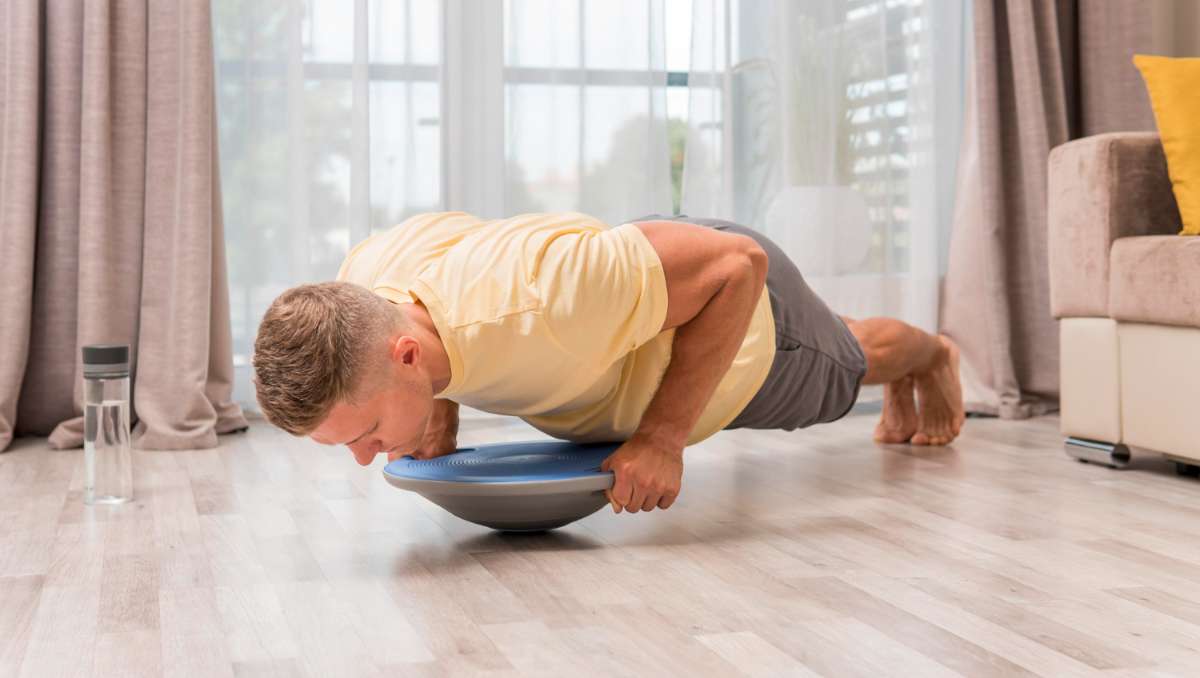If your workouts have hit a plateau or your core routine feels a bit one-dimensional, it might be time to bring in an underrated game-changer: balance board exercises. At first glance, a balance board might look like a quirky piece of gym equipment but don’t let its simplicity fool you. This wobbly platform challenges your core, improves coordination, and sharpens your stability in ways that traditional floor exercises just can’t match.
Key Takeaways:
- Balance boards are effective tools for building core strength, stability, and coordination. They activate deep stabilizing muscles through dynamic and functional movements.
- Balance board exercises such as basic balance, squat, planks, lunge, and push-ups range from basic holds to advanced full-body movements, suitable for all levels.
- Consistent practice (10–20 minutes a day, 3–5 times a week) delivers noticeable results.
In this guide, we’ll walk you through 10 effective exercises that go beyond the basics. Each is designed to wake up your core and train your body to move with more control, confidence, and balance.
What is a Balance Board and How Does it Work?
A balance board is a simple yet powerful training tool designed to improve stability, coordination, and core strength by challenging your body to maintain equilibrium on an unstable surface. It typically consists of a flat, sturdy platform that rests on a fulcrum, like a roller, dome, or wobble base, allowing it to tilt in multiple directions. The moment you step onto it, your muscles are forced to engage in subtle, continuous adjustments to keep you upright. This constant micro-movement activates deep core stabilizers, strengthens ankles and knees, and enhances proprioception—your body’s ability to sense its position in space.
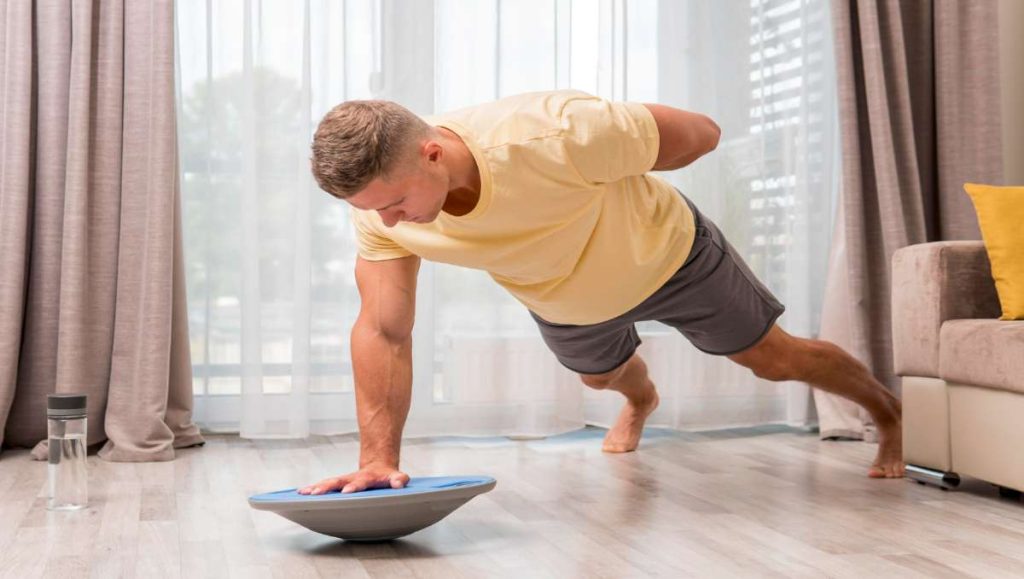
10 Balance Board Exercises to Improve Core Strength and Stability
Balance board exercises challenge your stability in all directions, forcing your core muscles to work overtime while training balance, coordination, and control. Here’s a guide to mastering the 10 best balance board exercises for your core and stability:
1. Basic Balance Hold
Difficulty Level: Beginner
A foundational exercise that helps you get used to the feel of the board while activating deep core and leg muscles.
- Stand with both feet shoulder-width apart on the balance board.
- Keep your knees slightly bent and arms out for balance.
- Try to maintain a steady, centered position for 30–60 seconds without letting the edges touch the ground.
- Focus on engaging your core and adjusting through your ankles and hips.
2. Squat on Balance Board
Difficulty Level: Intermediate
This variation of a basic squat adds instability, forcing your glutes, quads, and core to stabilize with every rep.
- Stand on the balance board with feet shoulder-width apart.
- Lower into a squat by pushing your hips back and keeping your chest up.
- Keep your weight evenly distributed as you lower and rise.
- Aim for 10–12 reps, keeping slow, controlled movements.
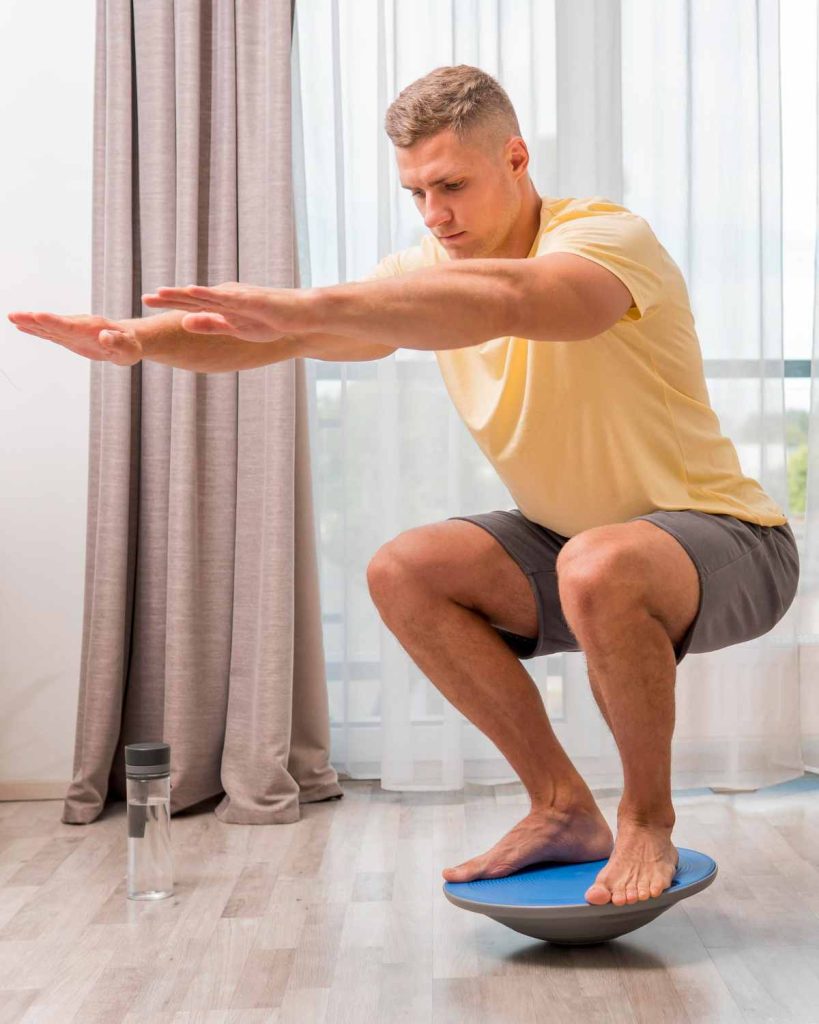
3. Plank Balance
Difficulty Level: Intermediate
This core burner takes a traditional plank and adds an extra challenge by destabilizing your base of support.
- Place your forearms or hands on the balance board, shoulders stacked above them.
- Extend your legs behind into a straight plank position.
- Keep your body in a straight line from head to heels.
- Hold for 20–45 seconds, focusing on not letting the board wobble.
4. Lunge with Balance Board (Front or Rear Foot Elevated)
Difficulty Level: Intermediate to Advanced
By elevating one foot, this move targets single-leg strength and control while engaging your core to maintain posture.
(Rear Foot Elevated):
- Place your rear foot on the center of the balance board behind you.
- Step your front foot forward into a lunge stance.
- Lower your back knee toward the floor, keeping your front knee aligned over your ankle.
- Push through your front heel to rise back up. Perform 8–10 reps per leg.
(Front Foot Elevated):
- Place your front foot on the balance board and rear foot on the ground.
- Lower into a lunge while keeping your balance centered.
- Maintain control as you rise back to start. Repeat for 8–10 reps per leg.
Alex Lee, a licensed physiotherapist and strength coach, recommends a deceptively simple variation: standing on one foot and extending the other in different directions—front, side, and back.
“It seems elementary, but it engages your entire body. Your ankles, knees, hips, and even your core muscles all have to engage in order to balance you. I work on this exercise extensively with my clients, both those returning from an injury as well as those looking to enhance balance and strength.”
5. Side-to-Side Tilts
Difficulty Level: Beginner
A simple, dynamic movement that targets lateral stability and hip control.
- Stand with feet hip-width apart on the board.
- Slowly tilt the board from side to side, letting one edge gently tap the floor, then the other.
- Keep your knees slightly bent and core engaged.
- Perform for 30–60 seconds in a controlled, rhythmic motion.
6. Push-ups on Balance Board
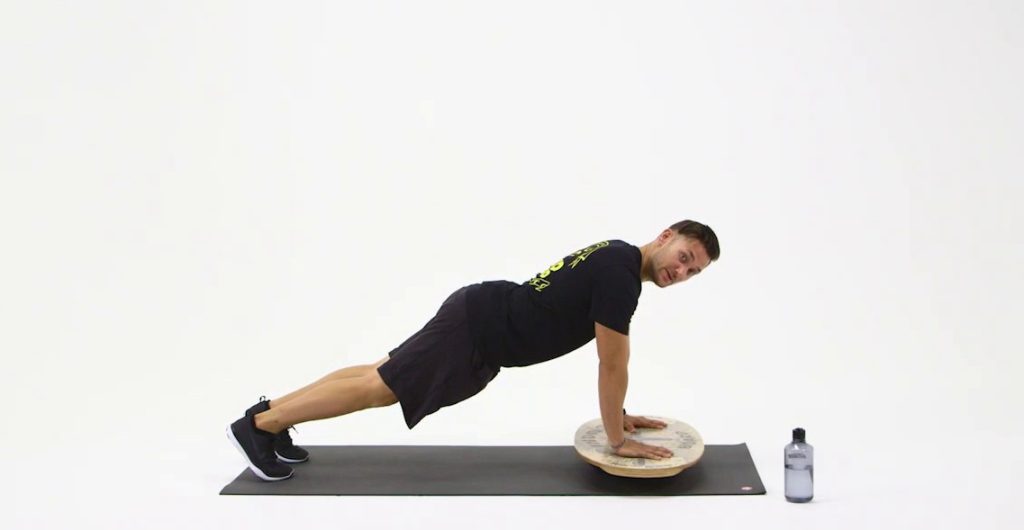
Difficulty Level: Intermediate to Advanced
Adding a balance board under your hands or feet during push-ups increases core engagement and shoulder stabilization.
- Place your hands shoulder-width apart on the balance board (or feet, for a different variation).
- Extend your legs behind you into a plank position.
- Lower your chest toward the board while keeping your elbows close to your body.
- Push back up with control, keeping the board as steady as possible. Aim for 8–12 reps.
7. Bird Dog Balance
Difficulty Level: Intermediate
This balance-heavy exercise enhances core stability, coordination, and control of opposing limbs.
- Begin in an all-fours position with hands and knees on the balance board.
- Slowly extend your right arm forward and your left leg back at the same time.
- Hold for 3–5 seconds, then return to center without losing balance.
- Repeat on the opposite side. Perform 6–8 reps per side.
8. Hip Bridges (Feet on Balance Board)
Difficulty Level: Beginner to Intermediate
Placing your feet on the board during hip bridges engages the hamstrings and core while adding instability to test control.
- Lie on your back with your feet hip-width apart on the balance board.
- Bend your knees and place your arms flat beside you.
- Press through your heels to lift your hips off the ground, squeezing your glutes at the top.
- Slowly lower back down. Repeat for 10–15 reps.
9. Standing Oblique Crunches on Board
Difficulty Level: Intermediate
A standing core move that targets the obliques while challenging balance and posture control.
- Stand on the board with your feet hip-width apart and hands behind your head.
- Shift your weight slightly to one side and lift your opposite knee toward your elbow.
- Crunch your torso sideways while maintaining your balance.
- Return to center and repeat on the other side. Perform 10 reps per side.
10. Mountain Climbers on Balance Board
Difficulty Level: Advanced
This high-intensity movement improves core activation, coordination, and cardiovascular endurance—all at once.
- Place your hands firmly on the balance board and extend your legs into plank position.
- Drive one knee toward your chest, then quickly switch to the other.
- Continue alternating legs in a quick, controlled rhythm.
- Aim for 20–30 seconds per set, maintaining form throughout.
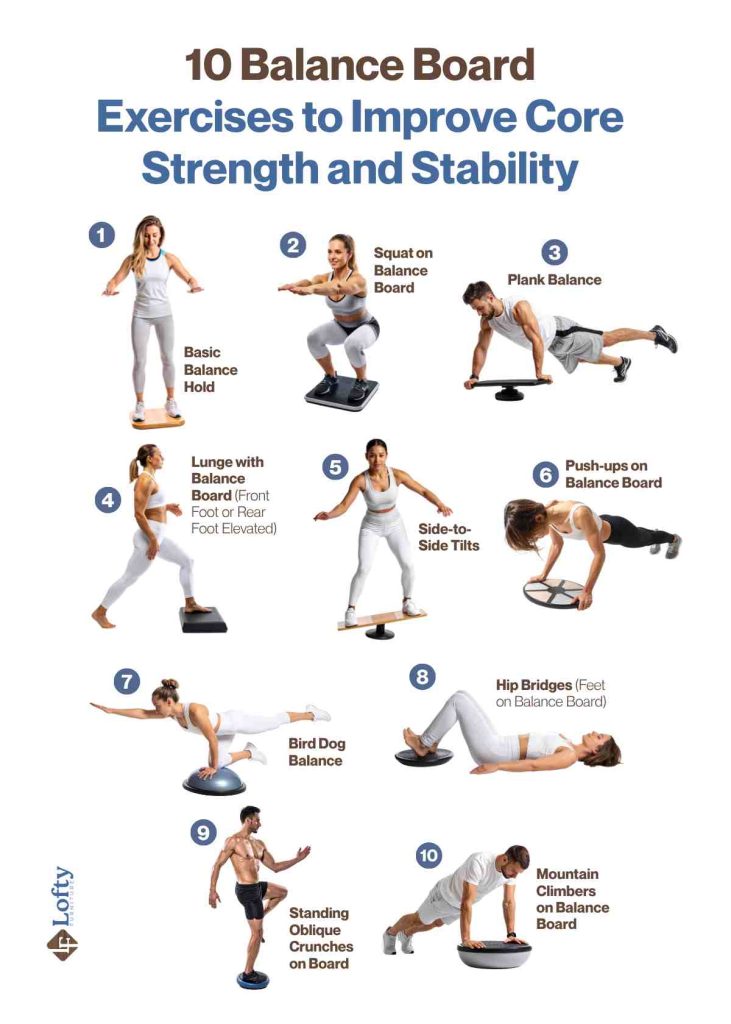
The Benefits of Balance Board Training
Balance board training is a fun, effective way to build strength that supports everyday movements. It targets the stabilizing muscles in your core, back, and hips, which are key for posture, injury prevention, and performance. Unlike traditional ab exercises, balance training engages your entire body. Whether you’re squatting, doing push-ups, or just standing, your body is always adjusting to stay balanced, making the workout more functional. Lee says:
“Balance board exercises help get your body and brain in the habit of working as a team together. They help improve something called proprioception, how well your body can sense where it is in space. It keeps you upright rather than toppling over, and allows you to respond quickly when you must.”
But the benefits don’t stop at physical strength. Balance board exercises also sharpen neuromuscular coordination, which is your brain’s ability to communicate effectively with your muscles. This leads to quicker reflexes, better control over your movements, and improved reaction time—key for sports and daily life.
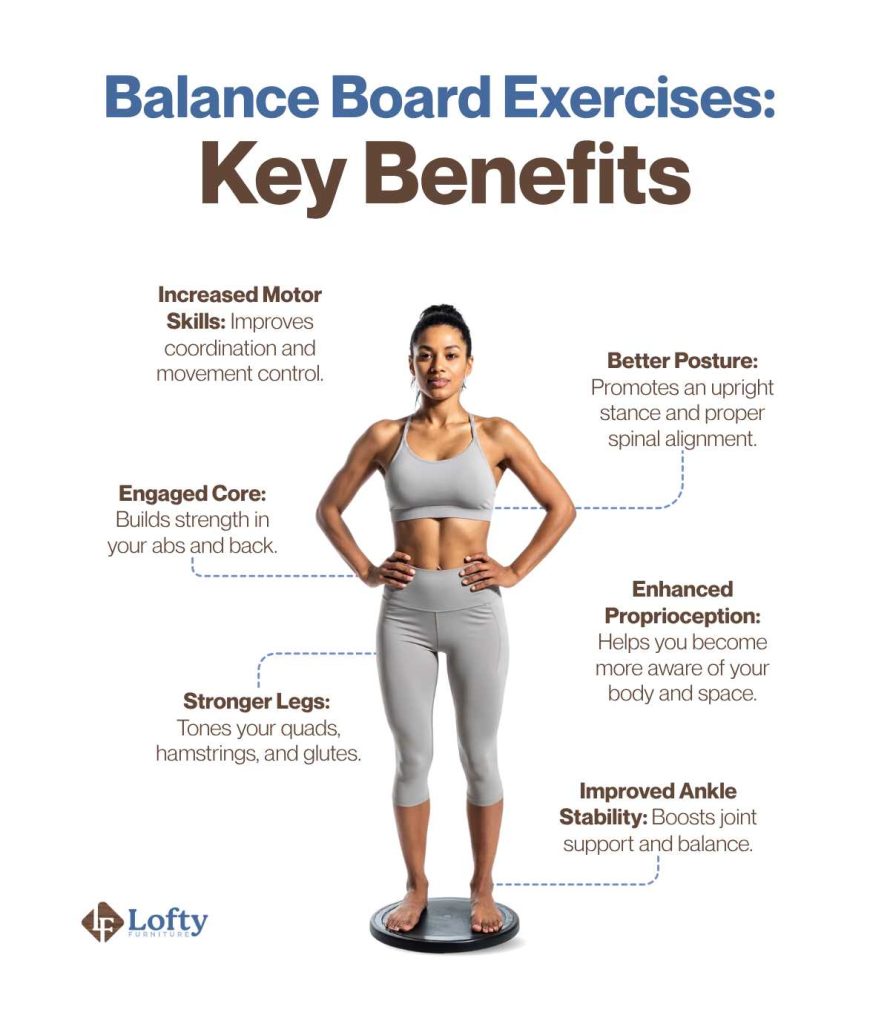
How to Choose the Right Balance Board
Choosing the right balance board depends on your fitness goals, experience level, and how you plan to use it. Some boards are designed to be beginner-friendly and rehab-safe, while others offer more dynamic, sport-specific challenges. Key factors to consider include the type of movement the board allows (tilting in one direction versus 360-degree wobble), the material and grip of the surface, and how much instability you’re ready to handle. If you’re just getting started or using the board for recovery, a model with controlled, limited motion might be best.
Below is a quick guide to help you understand the most common types:
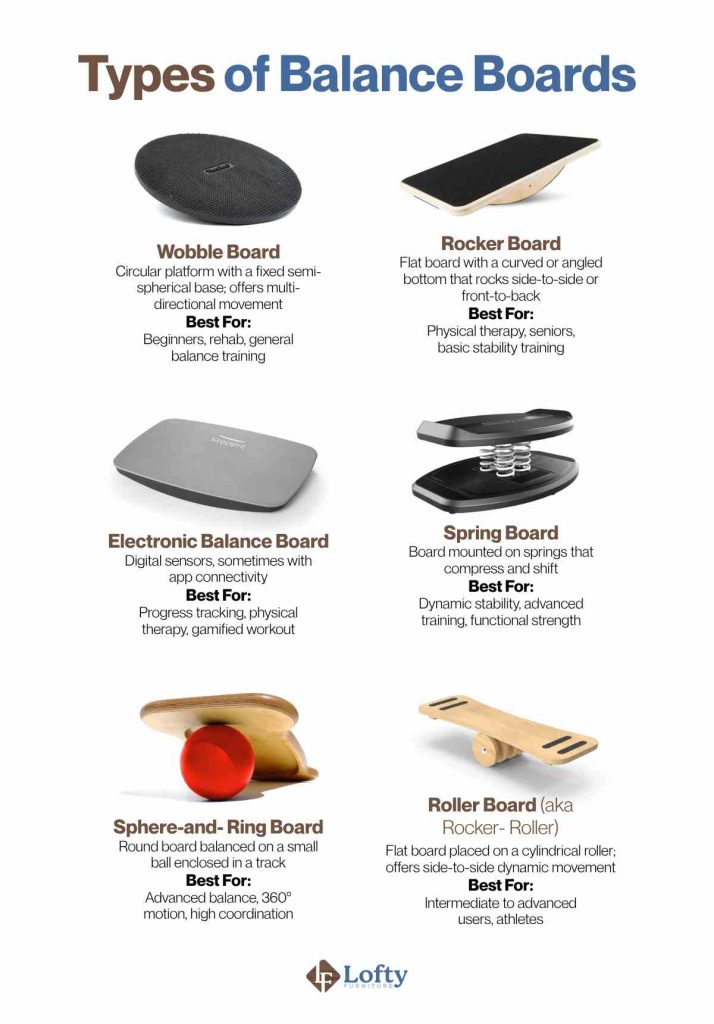
Ready to intensify your core workouts and conquer instability? Get your own hardwood wobble balance board today and revolutionize your exercise routine.
Getting Started Safely
When you’re new to balance boards, safety should be your first priority. Start on a flat, non-slip surface with enough space around you, and stay close to a wall or sturdy chair for added support. Go barefoot or wear shoes with good grip to stay steady, and avoid socks, which can be slippery. Begin with basic standing exercises, engage your core, and move slowly as you build confidence. If you have joint pain, vertigo, or other balance concerns, it’s best to check with a healthcare provider before getting started.
Balance board training is highly adaptable, which makes it great for all fitness levels. Progress happens naturally as your stabilizer muscles strengthen and your body learns to respond to shifting movement. Start with static holds or slow weight transfers, then work your way up to more dynamic moves like lunges or push-ups. Customization is also key; you can adjust exercises to suit rehab goals or athletic training by targeting different muscles or movement patterns. The most important thing is to stay consistent, listen to your body, and remember that balance is a skill built over time.
Lee advises starting simple and building gradually:
“Begin with the basics. Stand by the wall so you won’t tumble. Begin with standing stationary and progress to moving arms or legs gradually. You don’t have to do it for hours, 5 to 10 minutes daily is perfect. I advise my students to remove shoes so the foot can sense the board better.”
Who Should Use Balance Boards? (and Who Shouldn’t)
Balance boards can help athletes, fitness enthusiasts, older adults, and even office workers improve core strength, coordination, and stability. They’re commonly used in sports training and rehab to mimic dynamic movement and support recovery from ankle, knee, or hip injuries.
But they’re not for everyone. People with severe balance issues, vertigo, or recent injuries should check with a doctor first. Pregnant women in later stages and those with joint pain or limited mobility may be better off starting with gentler tools like foam pads or seated balance exercises.
Finding Your Balance: The Takeaway
Incorporating a balance board into your routine doesn’t require a complete fitness overhaul; just a willingness to step out of your comfort zone and challenge your body in new, functional ways. The instability might feel awkward at first, but over time, that’s exactly what makes your body more resilient, agile, and in tune with itself. Remember, progress with balance training is gradual—and that’s a good thing. The beauty of balance board training lies in its versatility and scalability, making it a smart addition to nearly any fitness goal.
Frequently Asked Questions
How often should I do balance board workouts for noticeable results?
For best results, aim for 3 to 5 sessions per week, even if they’re short (10–15 minutes). Consistency is key. Your neuromuscular system adapts best with regular, focused practice.
Should you wear shoes on a balance board?
It’s best to train barefoot on a balance board, as it helps strengthen your feet and improves balance more effectively. However, if you prefer wearing shoes, make sure they have good traction on the bottom to prevent slipping.
How long should I spend on a balance board each day to see results?
Spending just 10 to 20 minutes per day on a balance board can yield improvements in stability, posture, and core strength within a few weeks. You can also integrate the board into other workouts to maximize its benefits.
